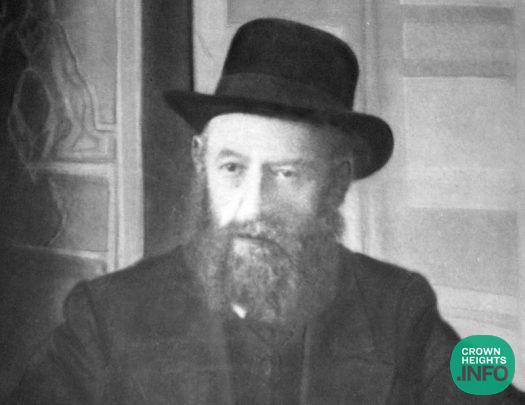
Weekly Story: Beis Nissan
Rabbi Sholom D. Avtzon
Last week’s post about my interaction with Reb Zalman Shimon Dworkin, was well-received, with numerous comments and emails, although some questioned if the lights were fluorescent or not. Additionally, someone emailed me that his Rov, although paskened on the question if an animal is kosher or not, did not partake of the meat when he decided it is kosher.
I was thinking of replying this week with a story of the Alter Rebbe about this custom, however, being that this Motzei Shabbos is Beis Nissan the yahrzeit of the Rebbe Rashab, I felt it is appropriate to post something about him. I took some points from my introduction to his biography.
I thank those who contact me directly or post a comment as this helps me decide what I should post in the future.
Bezras Hashem, I will be leading the farbrengen Sunday night (8:30) in Lefferts Shul.
It is well known that he wrote his first tzavaah (will) when he was not yet thirty years old, as he was suffering from a serious health condition at that time.[1] But he survived and lived for another thirty years, and he accomplished tremendous things, in both the expounding of Chassidus and his communal work. I therefore assumed that he recovered from that illness, and afterwards, he merely experienced some bouts of illness here and there.
However, that is far from the truth. Ever since he had tuberculosis at the age of nineteen,[2] his health was frail. In 5643 (1883), the year of aveilus for his father, the Rebbe Maharash, he was only twenty-two years old. Yet, the Rebbe Rashab stayed in Lubavitch for only around the first five months, after which he went to health centers. His son, the Frierdiker Rebbe, writes that a few years later, he barely saw his father for almost two full years (5645–5646/1885–1886), to the extent that he almost forgot his father’s love for him.[3]
In fact, it seems that for the thirty-three years of his nesius in Lubavitch,[4] he probably was out of Lubavitch more than he was there. I was under the impression that his father, the Rebbe Maharash, was physically the frailest of all of the Rebbeim,[5] as he was ill, under constant care of doctors, and only lived for forty-eight years. Now, however, it seems that his son and successor, the Rebbe Rashab, was equally frail in health for most of the fifty-nine years of his life.
Another misconception that became clarified: The Rebbe Rashab appointed his son, HaRav Yosef Yitzchok, as his secretary and representative when he turned fifteen,[6] and indeed, the Frierdiker Rebbe worked with mesiras nefesh even before he became Rebbe. That was less than two years after the Rebbe Rashab accepted the nesius completely, on Rosh Hashanah of 5654 (1893), and began taking an active part in communal affairs.[7] It appeared to me that he delegated an incredible amount of work to him, while he devoted his time to davening and learning. Yet, I found the extent of his involvement in communal matters to be astounding.
Everything the Frierdiker Rebbe did was at his father’s behest. Even with regard to Tomchei Tmimim, where the Frierdiker Rebbe was appointed as the menahel poel (executive director) and had the final say and decision, he would always ask his father how to proceed. For example: There is an essaywritten by the Frierdiker Rebbe called Klalei Hachinuch V’Hahadrachah.I was under the impression that it was the Frierdiker Rebbe’s own work, as it is printed as an addendum to his Sefer HaSichos 5703 (1943). However, after studying it, one sees that it is comprised almost exclusively of the notes and directives he had received from his father, who then instructed him, as his secretary, to commit them to writing.[8]
The Rebbe Rashab’s father, the Rebbe Maharash, and his grandfather, the Rebbe the Tzemach Tzedek, dealt with the Czarist government and battled the maskilim throughout their nesius, to prevent them from implementing changes in the way the local chadorim taught their students. With the Rebbe Rashab, this was also a constant battle, but it was only one part of his communal responsibilities. During his nesius, there were wars[9] and upheavals throughout Russia, demanding a tremendous amount of energy and attention to additional matters.
The Czar continuously enacted new regulations against the Jews. The resulting pressure was so severe that between the years 5640 and 5680 (1880–1920), the years of the Rebbe Rashab’s nesius, over two million Jews emigrated from Russia (comprising a third of Russian Jewry). The vast majority of those who remained were unemployed, restless, hungry, and not completely quiet. Many of them joined the various movements that sprouted throughout Russia, demanding an end to the Czar’s totalitarian power.
When the Jewish communal leaders pleaded with the officials to alleviate some of their draconian decrees and make the lives of the populace more bearable, they were ignored. To the contrary, the government’s response to these protests and to the populace’s unrest was along the lines of, “Either you rabbis and leaders control your youth, or we will incite the populace to vent their frustration on the hapless Jews instead of on the government.” Indeed, in 5665 (1905), numerous pogroms occurred, in which many Jews were killed and entire communities were ravaged and deprived of their possessions.
In order to show that the attacks were spontaneous (and not arranged by the government), the government used the media to spread anti-Semitic sentiments. The most flagrant attempt was when they initiated the infamous blood libel against Mendel Beilis in 5671 (1911), to arouse the anger of the populace against the Jews.
In addition to using this libel to direct the frustration of the peasants against the Jews, the government was trying to accomplish another objective. They specifically tried to implicate the Rebbe Rashab in the killing of the child, so they would be able to arrest him or at least intimidate him and silence his opposition to their plans.[10]
In these extremely difficult times, when the Jews were made to feel unwanted and unwelcome, many of them joined or even led various new societies that demanded an end to the crushing control of the government. Once they threw off the mantle of obedience to the Czar, many of them also rebelled against all authority, including the ways of the Torah. This was especially true with those who joined the Zionist movement.[11]
This rift became so severe that not only did some of the Jewish youth throw off the yoke of Torah, they even harbored hatred against those who were observant. They once damaged the Rebbe Rashab’s house and tried to kill his son.[12]
It seemed as if every year there was a new, additional “fire” that needed to be extinguished or held in check, in addition to the ongoing battles against the government and the maskilim. So yes, he dealt with an unbelievable amount of communal issues.
This realization changed my perception of who the Rebbe Rashab was.
We all grew up with the saying of chassidim that the Rebbe Rashab was the Rambamof Chassidus.[13] Just as the Rambam organized the entire Torah She’Baal Peh into precise topics,[14] the Rebbe Rashab elucidated the concepts of Chassidus in an orderly fashion. Furthermore, just as the Rambam finalized the discussion and paskened the definite halachah, the Rebbe Rashab reconciled seemingly opposing ideas in Chassidus. By clarifying how both ideas are relevant and true, as they are referring to different levels, it is as if he, too, paskened the “halachah.”[15]
His maamorim are known for their depth and clarity. His son related the extent of his father’s concentration on Chassidic thought: Once, his father contemplated on a concept throughout the night, and the Frierdiker Rebbe sensed that his father had lost track of time.[16]
All this reinforced my impression that for the most part, the communal activities were handled by his son. After all, how does one have time for both?!
Yet, somehow he was able to be preoccupied for weeks on end with contemplating and developing a concept in Chassidus, without that interfering with his participation in communal affairs, often in a forceful manner.
Rabbi Avtzon is a veteran mechanech and the author of numerous books on the Rebbeim and their chassidim. He can be contacted at avtzonbooks@gmail.com
I am pleased to notify that Early Chassidic Personalties vol. 5, – The Brothers of Slavita is back in print and bezras Hashem vol. 1, – Reb Shmuel Minkis is going to the printer this coming week.
[1]. This will is published in the booklet Chanoch Lanaar.
[2]. Reshimas Hayoman, p. 334.
[3] Likkutei Dibburim vol. 4, p. 1346.
[4] He was Rebbe for thirty-seven years, from 5643 until 5680 (1882–1920). However, during the final four years of his life he lived in Rostov.
[5] While the Mitteler Rebbe was also frail and wasn’t allowed to exert himself, with proper care he was able to live as usual, without the constant need of traveling to various health resorts and specialists.
[6] See below, “Appointing His Son as His Assistant.”
[7] See below, “Accepting the Nesius.”
[8] As noted, Klalei Hachinuch V’Hahadrachah is printed as an addendum to Sefer HaSichos 5703, pp. 206–230. However, on pp. 180–189 there, the Frierdiker Rebbe describes in detail how all the material for the essay came from his father. His father gave him his notes and instructed him to write them down in an organized fashion. The Frierdiker Rebbe then showed the work to his father a few times and received clarifications, corrections, and additions, until it was finally ready.
This work was written in the summer of 5658 (1898). The Rebbe Rashab instructed that it be given to the mashpi’im Reb Shmuel Gronem Esterman, who headed the yeshiva in Zhembin, and Reb Chanoch Hendel Kugel, who headed the yeshiva in Lubavitch.
[9] Most notably, the Russo-Japanese War in 5664–5665 (1904–1905), and World War I in 5674–5678 (1914–1918), where Russia initially suffered humiliating and devastating defeats.
[10] See below, “The Blood Libel Against Beilis.”
[11] See below, “Battling Zionism.”
[12] See below, “The Pogrom in Lubavitch.”
[13] Likkutei Dibburim, vol. 2, p. 591.
The Rashbatz also said that the Rebbe Rashab was like the Ran (Rabbeinu Nissim), who was able to split a sevara (intellectual concept) into numerous parts. (Sefer HaSichos 5704, p. 19)
In Likkutei Dibburim (vol. 3, sec. 22, p. 782) it is noted that chassidim also referred to the Rebbe Rashab as the Chovos Halevovos of Chassidus. Just as the Chovos Halevovos explains complex thoughts and gives them a practical application, the Rebbe Rashab explained the most sublime concepts of Chassidus in a way that a regular person can understand and apply to his life.
[14] Specifically, into fourteen general topics (the fourteen volumes of Mishneh Torah), which are subdivided into eighty-four sections.
[15] Toras Menachem 5742, vol. 1, p. 209.
[16] See below, “His Seforim.”













